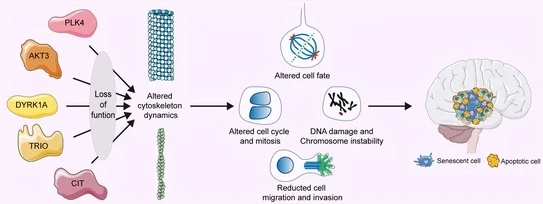
Whatsapp 93125-11015 For Details


Context
Understanding Microcephaly
1. Clinical Manifestations: Microcephaly manifests with a smaller-than-normal head size, often accompanied by intellectual disabilities, poor motor function, speech impairments, and distinct facial features. Its origins are rooted in disrupted brain development during the embryonic phase, where aberrant cell division of neuronal precursor cells occurs.
2. Diagnostic Techniques: Clinicians employ prenatal ultrasound and magnetic resonance imaging (MRI) to diagnose microcephaly before birth, allowing for early intervention and management strategies.
The SASS6 Gene: A Key Player
1. Gene Implication: Since 2014, the SASS6 gene and its variants have been implicated in the pathogenesis of microcephaly. Studies highlight the crucial role of SASS6 in centriole assembly, essential for cellular division and subsequent neuronal differentiation.
2. Functional Implications: Research findings underscore the importance of functional SASS6 genes for cellular differentiation, particularly evident in studies involving mouse embryo-derived cells. The absence of functional SASS6 genes impedes centriole formation, crucial for neuronal differentiation, elucidating the genetic basis of microcephaly.
Genetic Risk and Consanguinity
1. Consanguinity Impact: Geneticists identify consanguineous marriages as significant contributors to congenital microcephaly cases, increasing the likelihood of inheriting mutated copies of genes from both parents. The risk escalates with the rarity of the mutated gene in the general population.
2. Mutational Spectrum: Microcephaly can stem from mutations in various genes, with 30 genes implicated in its etiology. Notably, mutations affecting centriole assembly and spindle formation during cell division play pivotal roles.
The Ile62Thr Mutation: Unraveling the Molecular Basis
1. Discovery and Characterization: Researchers discovered the SASS6 gene and its protein's evolutionary conservation across species, highlighting its fundamental role in cellular dynamics. The Ile62Thr mutation, correlated with microcephaly, underscores the critical amino acid alterations disrupting centriole assembly.
2. Functional Consequences: While individuals with slightly defective SASS6 genes may survive to adulthood, the severity of neurological deficits underscores the neuronal sensitivity to centriole aberrations. The finicky nature of neuronal cells renders them highly susceptible to imperfect centrioles, elucidating the profound impact of SASS6 mutations on brain development.
Conclusion: Navigating Cellular Sensitivity